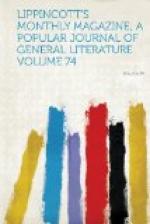Nor was Dickens so absorbed in his work as to leave it reluctantly, or to find no fullness of satisfaction in occupations or enjoyments of a different kind. On the contrary, no man ever threw himself so heartily and entirely into the business of the hour, or more eagerly sought diversion and change. Dinners, private and public, excursions in chosen companionship, amateur theatricals, schemes of charity or benevolence, occupied a large portion of his time, and were entered into with an ardor which never flagged or needed to be stimulated. His correspondence—an unfailing barometer to indicate the state of the mental atmosphere—is always full of life, overflowing, for the most part, with animal spirits, often vivid in description both of places and people, turning discomforts and embarrassments into subjects of lively narrative or indignant protest. The letters from Genoa and Lausanne are especially copious and entertaining, and form, we think, the most interesting portion of the book. The later chapters, giving the final year of his residence in Devonshire Terrace, are less satisfactory. We would fain have had a picture of that circle of which Dickens was one of the most prominent figures; but though his own personality is revealed in the fullest light, the group in the background is left indistinct, most of its members being barely visible, and none of them adequately portrayed.
* * * * *
Emaux et Camees. Par Theophile Gautier. Nombre definitif. Paris: Charpentier; New York: F.W. Christern.
Gautier was polishing and adding to his literary jewelry almost to the day of his death, and the final edition which he published among the last of his works about doubles the number of poems first issued. These verses are like nothing we have in English. Their imagery is strongly sophisticated, tortured, brought from vast distances, and then chilled into form. Yet they are the most sincere utterances of a soul fed perpetually among cabinets and picture-galleries, to whom their compact method of utterance is, so to speak, secondarily natural. That they are precious and beauteous no one can deny. How sparkling are the successive descriptions of women—blonde, brune, Spanish, contralto-voiced, coquettish, etc.—whom the poet, like some capricious artist, invites into his atelier, drapes hastily with old Moorish or Venetian or diaphanous costumes, and then reflects in a diminishing mirror, changing the model into a fine statuette of ivory and enamel! More virile and thoughtful images are intermixed: such are the figures of the old Invalides seen at the Column Vendome in a December fog, and for whom he pleads: “Mock not those men whom the street urchin follows, laughing: they were the Day of which we are the twilight—maybe the night!” Not less fresh are the two “Homesick Obelisks”—that in the Place de la Concorde, wearying its stony heart out for Egypt, and that at Luxor, equally tired, and longing to be planted




